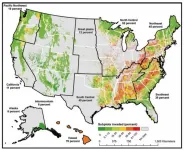(Press-News.org) When most Americans imagine an archaeologist, they picture someone who looks like Indiana Jones. Or, perhaps, Lara Croft, from the Tomb Raider game. White, usually male but occasionally female, digging up the spoils of a vanished culture in colonized lands.
Depictions of archaeologists in popular culture mirror reality. Many scholars have noted the experts institutions recognize as authorities to discuss or represent the past are overwhelmingly white and mostly male. Archaeology has also been a tool colonizing countries use to consolidate and justify their domination. As a new open-access paper in American Antiquity points out, the first doctoral degree in archaeology was not granted to a Black woman until 1980.
First author Ayana Omilade Flewellen, an assistant professor of anthropology at UC Riverside and co-founder of the Society of Black Archaeologists, is working to change this by investigating antiblackness within the discipline, increasing the visibility of Black archaeologists and changing how archaeologists are portrayed in the media, and developing strategies to get more Black students to study archaeology.
"Public-facing avenues for history-making have historically excluded Black and Brown people," Flewellen said. "It has been white, extracting value from and not in dialogue with surrounding communities. How can we be part of history making? How can we get more excluded communities engaged in this work?"
The paper urges archaeologists and history professionals to work closely with people who are grappling with racism in public monuments and institutional names in the wake of last year's uprising following the killing of George Floyd. The authors argue that by working with "broad publics who are actively dictating what should be preserved and what should not the field can begin to redress the harm it has perpetuated."
"The past is messy," Flewellen said. "And archaeologists, we're in the dirt."
The authors assert that professionals of color who deal with history, whether as archaeologists, historians, museum curators, or other heritage experts, are often accused of bias in topics related to slavery, racism, or genocide. Their scholarly or public-facing work is often said to lack objectivity or express excessive emotion. The work of white scholars, writing on the same topics, is considered objective and taken more seriously.
"People question the objectivity of Black scholars but everyone, including white scholars, always has our own biases," Flewellen said. "But embracing these biases by working closely with communities, including Indigenous and Asian, usually excluded from history making allows us to have a more human image of the past."
For example, the authors suggest monuments damaged by protestors could be preserved and displayed alongside exhibits contextualizing the damage as part of a broader history that includes the oppression and struggle for equality of Black, Brown and Indigenous peoples in America. Defacing or destroying monuments could be seen not as an attempt to erase history but rather, as part of an active process of making history.
Recognizing acts of Black resistance against such monuments and other markers of white supremacy makes for a more objective, inclusive, and human telling of history, the authors argue. It also shifts attention from a preoccupation with preservation toward critical examination of the histories scholars choose to see, excavate, and steward.
The paper also addresses the challenges of bringing more Black college students into archaeology, which, in America, is usually housed in anthropology departments.
"Many Black students don't even have access," Flewellen said. "Historically Black colleges and universities don't usually have anthropology majors, and there are financial barriers as well. Field schools, necessary to complete training, are expensive, and because there are so few Black archaeologists, it's also hard for Black students to find mentors."
The authors argue Black archaeology, a specialization shaped by Black Feminist theory focusing on Africa and the African Disapora, can help bring more Black people, especially women, into archaeology and work against racism in the discipline.
"An antiracist archaeology is committed to forging sustainable and nurturing connections among archaeologists of all backgrounds, as well as with communities impacted by archaeological work, community organizers and activists, and those working with smaller historical societies that are also fighting to preserve local histories," the authors write.
The paper emerged from a forum last summer and calls on universities to:
Hire and advance more minority faculty and staff through tenure and promotion and into senior-level roles, respectively.
Make the process of obtaining tenure and merit reviews more transparent.
Admit more minority students and offer more scholarships to help them achieve a degree.
Train faculty and graduate students to integrate antiracist pedagogy in their classes.
Rethink curricula and syllabi to incorporate a greater diversity of voices and perspectives.
Reduce and respond to incidents of macro and microaggressions on campus, such as overtly racist abuse and small everyday insults that make for a hostile environment for students of color.
Hire counseling center staff members who are competent to address the psychological stress of minority students.
INFORMATION:
Flewellen was joined in the research by Justin P. Dunnavant at Vanderbilt University; Alicia Odewale at the University of Tulsa; Alexandra Jones with Archaeology in the Community; Tsione Wolde-Michael at the Smithsonian Institution; Zoë Crossland at Columbia University; and Maria Franklin at the University of Texas at Austin. The paper, "The future of archaeology is antiracist: archaeology in the time of black lives matter," is available here.
Cambridge, Mass. - When the first COVID-19 vaccines were approved for emergency use in December 2020, healthcare systems across the Unites States needed to rapidly design and implement their own approaches to distribute COVID-19 vaccines equitably and efficiently. This new role has required Beth Israel Lahey Health (BILH) to develop new strategies and build large operational teams to organize and successfully vaccinate more than 14,000 patients a week across Eastern Massachusetts. In an Insight article published in JAMA Health Forum, Leonor Fernandez, MD, Assistant Professor of Medicine in the Department of Medicine at Beth Israel Deaconess Medical Center (BIDMC) and Peter Shorett, MPP, Chief Integration Officer at ...
April 8, 2021 - Women undergoing surgery to treat stress urinary incontinence (SUI) are not at increased risk of developing pelvic cancers, according to a large-scale, population-based study in The Journal of Urology®, Official Journal of the American Urological Association (AUA). The journal is published in the Lippincott portfolio by Wolters Kluwer.
"In a very large population with extended follow-up, we found no increase in the risk of any pelvic malignancy in women who underwent stress urinary incontinence surgery," comments lead author Humberto ...
Detecting and analyzing breast cancer goes beyond the initial discovery of the cancer itself. If a patient has a tumor removed and it needs to be analyzed to determine further treatment, it might be OK for the results to take 24 hours. But if the patient is still on the operating table and clinicians are waiting to make sure no cancer cells are present along the edges of the removed tumor, results need to be nearly immediate.
A paper titled, "Breast cancer histopathology using infrared spectroscopic imaging: The impact of instrumental configurations," ...
Many Mario Kart enthusiasts are familiar with the rush of racing down Rainbow Road, barely squeaking around a corner, and catching a power-up from one of the floating square icons on the screen--or, less ideally, slipping on a banana peel laid by another racer and flying off the side of the road into oblivion. This heated competition between multiple players, who use a variety of game tokens and tools to speed ahead or thwart their competitors, is part of what makes the classic Nintendo racing game that has been around since the early 1990s so appealing.
"It's been fun since I was a kid, it's fun ...
Whatever ultimately caused inhabitants to abandon Cahokia, it was not because they cut down too many trees, according to new research from Washington University in St. Louis.
Archaeologists from Arts & Sciences excavated around earthen mounds and analyzed sediment cores to test a persistent theory about the collapse of Cahokia, the pre-Columbian Native American city in southwestern Illinois that was once home to more than 15,000 people.
No one knows for sure why people left Cahokia, though many environmental and social explanations have been proposed. One oft-repeated theory is tied to resource exploitation: specifically, that Native Americans ...
Scientists could be a step closer to finding a way to reduce the impact of traumatic memories, according to a Texas A&M University study published recently in the journal END ...
New Haven, Conn. -- Alzheimer's disease is known for its slow attack on neurons crucial to memory and cognition. But why are these particular neurons in aging brains so susceptible to the disease's ravages, while others remain resilient?
A new study led by researchers at the Yale School of Medicine has found that susceptible neurons in the prefrontal cortex develop a "leak" in calcium storage with advancing age, they report April 8 in the journal Alzheimer's & Dementia, The Journal of the Alzheimer's Association. This disruption of calcium storage in turns ...
WEST LAFAYETTE, Ind. - New insights into the immune response to SARS-CoV-2 infections could bring better treatments for COVID-19 cases.
An international team of researchers unexpectedly found that a biochemical pathway, known as the immune complement system, is triggered in lung cells by the virus, which might explain why the disease is so difficult to treat. The research is published this week in the journal Science Immunology.
The researchers propose that the pairing of antiviral drugs with drugs that inhibit this process may be more effective. Using an in vitro model using human lung ...
MADISON, WI, April 8, 2021 - USDA Forest Service scientists have delivered a new comprehensive assessment of the invasive species that confront America's forests and grasslands, from new arrivals to some that invaded so long ago that people are surprised to learn they are invasive.
The assessment, titled "Invasive Species in Forests and Rangelands of the United States: A Comprehensive Science Synthesis for the United States Forest Sector," serves as a one-stop resource for land managers who are looking for information on the invasive species that are already affecting the landscape, the species that may threaten the landscape, and what is known about control ...
Nobel laureate in physics Richard Feynman once described turbulence as "the most important unsolved problem of classical physics."
Understanding turbulence in classical fluids like water and air is difficult partly because of the challenge in identifying the vortices swirling within those fluids. Locating vortex tubes and tracking their motion could greatly simplify the modeling of turbulence.
But that challenge is easier in quantum fluids, which exist at low enough temperatures that quantum mechanics -- which deals with physics on the scale of atoms or subatomic particles -- govern their behavior.
In a new study published in Proceedings of the National Academy of Sciences, Florida State University researchers ...




